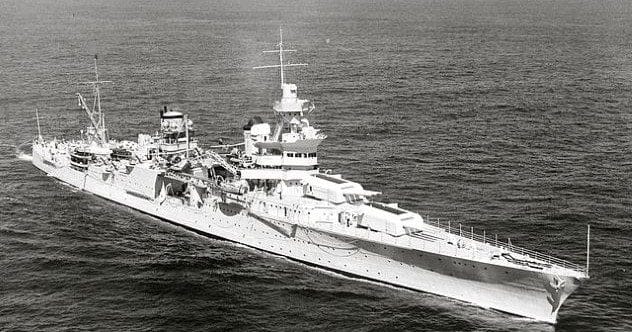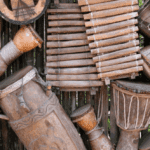On July 30, 1945, the USS Indianapolis became the last major American ship sunk in World War II. This tragic event resulted in the greatest loss of life from a single ship in U.S. Navy history. Of the Indianapolis’s 1,195-member crew, only 316 ultimately survived.
What’s even more remarkable is the horrific ordeal the ship’s crew endured in the open Pacific Ocean while desperately waiting to be found. Here are ten tales from WWII’s final American tragedy.
Precious Cargo
Fortunately for countless American soldiers, the Indianapolis was on the final leg of its intended journey when it was sunk.
In July 1945, the Indianapolis found itself back in America for repairs after being damaged by a Japanese fighter plane. As the ship departed San Francisco on July 16, it carried several giant wooden crates destined for the naval base at Tinian, a U.S.-occupied island. These crates contained uranium and components for the first atomic bombs.
The Indianapolis broke a speed record, reaching Pearl Harbor, Hawaii, in just 74½ hours. It then continued to Tinian, arriving on July 26. After delivering its covert cargo, the ship went to Guam, where many crew members were relieved and replaced. Soon, the Indianapolis set course for the Philippines but never made it. Had the ship been sunk prior to arriving in Tinian, the atomic bomb’s deployment would have been delayed. [1]
Straight to Its Death
In April 1912, the Titanic sank due to Captain Edward Smith ignoring warnings of icebergs and maintaining full speed. Similarly, during the final days of World War II, the USS Indianapolis was en route to the Philippines. Captain Charles McVay III led the ship in a straight trajectory, despite battleships being advised to zigzag to avoid enemy submarines. Intelligence reports claimed the waters were clear of Japanese submarines, but this was tragically incorrect.
At 12:15 am on July 30, the Japanese submarine I-58 struck the Indianapolis with two torpedoes. The ship rolled over and sank in just 12 minutes, leaving little time for lifeboats to be deployed. About 300 crew members went down with the ship. Unlike Captain Smith of the Titanic, McVay survived, but faced severe consequences. [2]
“Like Hell”: The Immediate Aftermath
When a ship as large as the Indianapolis sinks, survivors are scattered over a wide area, exacerbated by thick oil accumulating around the site. Seaman First Class Lyle Umenhoffer recalled his instinct to get away from the oil to avoid fire, swimming aimlessly without a life jacket. Most survivors were initially relieved when dawn broke, but their relief was short-lived.
Signalman Third Class Paul McGinnis described the sun as feeling “like having your head in a hole in the middle of a mirror,” with intense sunlight burning the skin. By noon, they longed for the darkness, but when the sun went down, they shivered with cold, eagerly awaiting its return. [3]
A Different Type of Sea Sickness
As the ordeal dragged on, survivors faced increasing obstacles. The most ironic threat was dying of thirst despite being surrounded by water. Many desperate sailors disregarded warnings and drank the salt water, which led to nausea, muscle weakness, and delirium.
The survivors, already weakened and injured, began to hallucinate. Some had visions of rescue ships or land, prompting them to separate from their comrades. Seaman First Class Lyle Umenhoffer noted that many would swim away, hallucinating and removing their life jackets. Many succumbed to exhaustion and drowned, while others attacked their fellow seamen, believing them to be Japanese spies. [4]
Jaws, Part 1: Feasting on the Dead
The USS Indianapolis holds another tragic distinction: it fomented the deadliest shark attack in recorded history. The scene presented a perfect storm for oceanic whitetip and tiger sharks, drawn by the exploding torpedoes and the wounded.
Initially, the sharks focused on the floating dead, releasing more blood into the water and attracting more sharks. The luckiest survivors were in lifeboats, while others struggled with only life jackets. Some survivors admitted hoping for the wounded to pass away, as their thrashing and blood attracted sharks. The living knew their best chance was to let the sharks feed on the dead, buying them more time. [5]
Jaws, Part 2: Eaten Alive
As the number of bodies decreased, the sharks turned their attention to the living. Edgar Harrell, a Marine, recalled hearing bloodcurdling screams as people were dragged under. An estimated 150 of the 900 initial survivors were killed by sharks.
Loel Dean Cox described the sharks bumping and circling his group. Sharks would come up and take a sailor straight down. One pilot saw a man eaten alive as he swam toward supplies dropped by a plane. [6]
Murder and Madness on the Open Sea
The combination of sharks, saltwater ingestion, sun, cold, thirst, and hunger drove men past their breaking point. Machinist’s Mate Second Class Granville Crane recalled men with weapons fighting and killing one another due to delirium.
The limited number of liferafts led to conflict. Exhausted men in the water stormed the liferafts, only to be beaten back by those inside, who feared capsizing. This macabre hierarchy played out for days, with survival often meaning sacrificing others. [7]
Overlooked and on Their Own
It took four days to find the survivors because nobody was looking for them. Command posts in Guam and the Philippines used rudimentary systems to track vessels. There was no check-in process to update a ship’s position or confirm its status.
On July 31, when the Indianapolis should have arrived in the Philippines, the command center in Guam simply erased it from the board. In the Philippines, Lieutenant Stuart B. Gibson noticed the ship’s absence but failed to investigate or report it. This, combined with ignored SOS signals from the ship, meant nobody initiated a rescue operation. The Navy later incorporated a Movement Report System due to this massive screwup. [8]
Finally Found
The sailors were saved by luck on the morning of August 2, three and a half days after the sinking. Lieutenants Wilbur Gwinn and Warren Colwell spotted survivors during a routine patrol mission. Nearby, a separate set of survivors was spotted by a PBY-2 Catalina seaplane. Both aircraft dropped liferafts and radioed for help.
Lieutenant Commander Robert Adrian Marks landed his seaplane despite opposing orders, rescuing over 50 survivors. After nightfall, the USS Cecil J. Doyle was the first of seven rescue ships to arrive, pulling the remaining 316 survivors to safety. [9]
Exonerated, Three Decades Too Late
The Indianapolis was sunk while traveling a straight route instead of zigzagging. Captain Charles McVay initially thought the ship could be saved, but after the torpedo strikes, he ordered distress signals. Eventually, he gave the order to abandon ship.
Of the 900 men who abandoned the ship, only 316 survived. McVay demanded to know why it took four days to rescue his men. Declassified documents revealed that three SOS signals were received but ignored. McVay was court-martialed for failing to zigzag and was convicted, becoming the only captain of nearly 400 U.S. ships lost in combat to suffer such a fate.
McVay was exonerated in 2001, thanks to a 12-year-old’s research. Unfortunately, this came 33 years too late for the disgraced captain, who committed suicide on November 6, 1968. [10]
What are your thoughts on these incredible tales of survival and tragedy? Leave your comment below.










